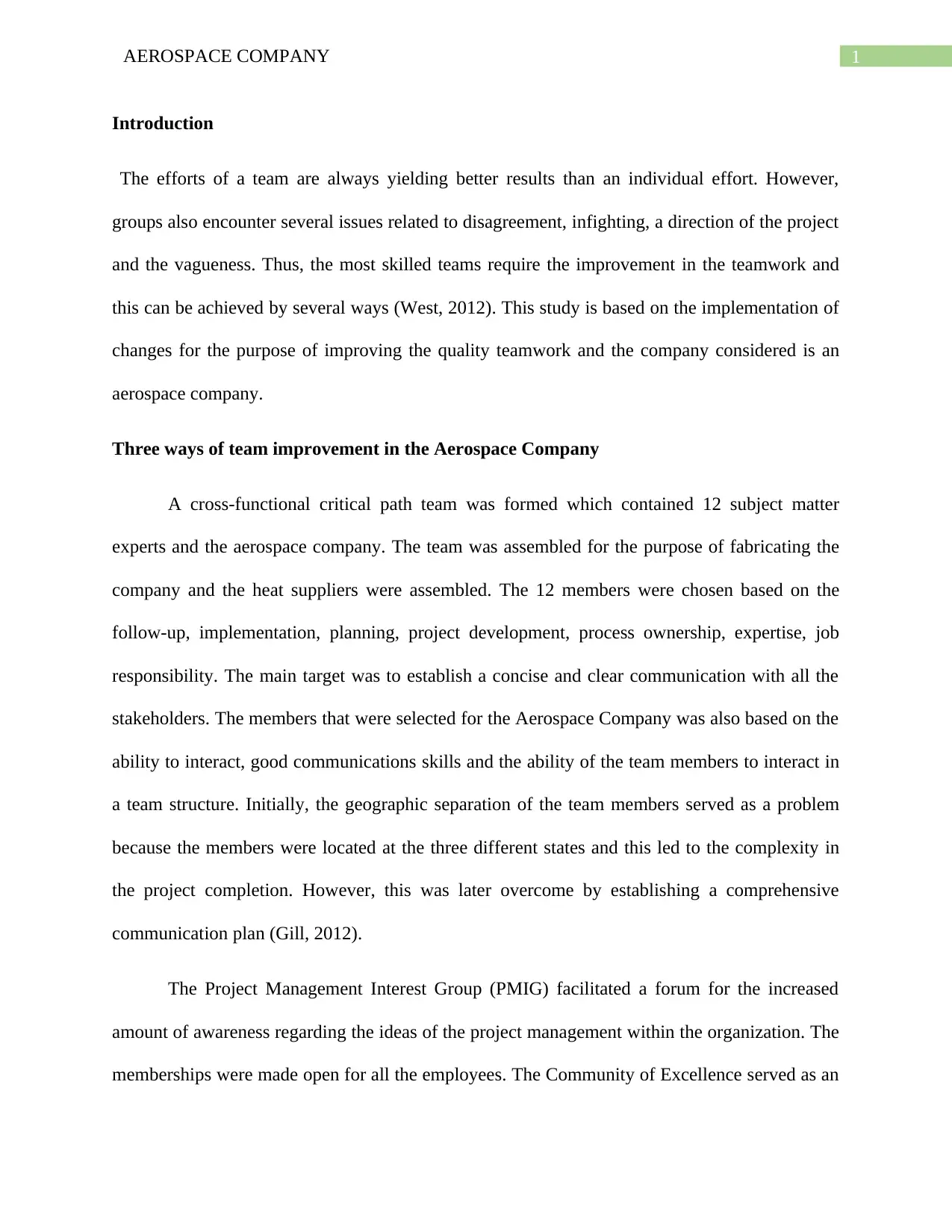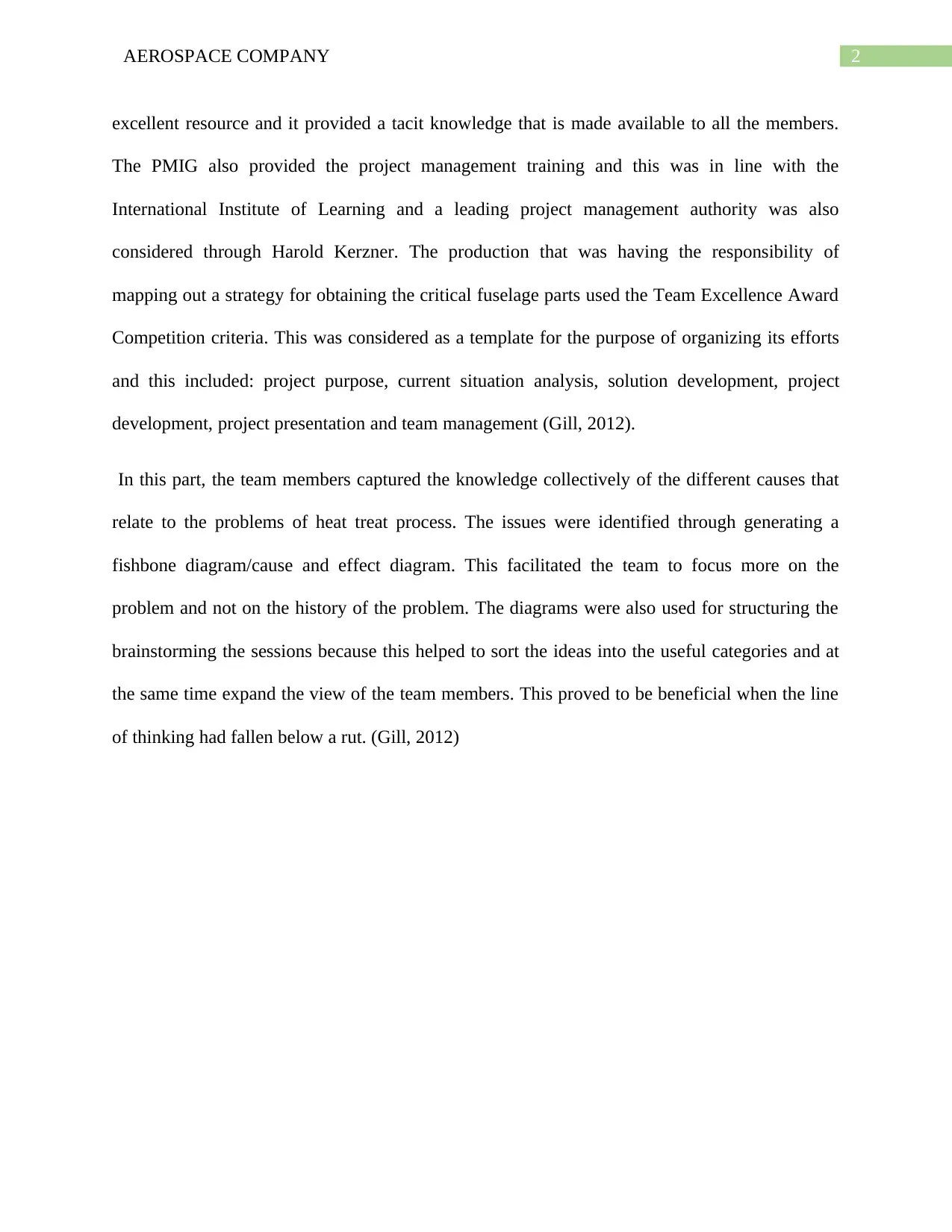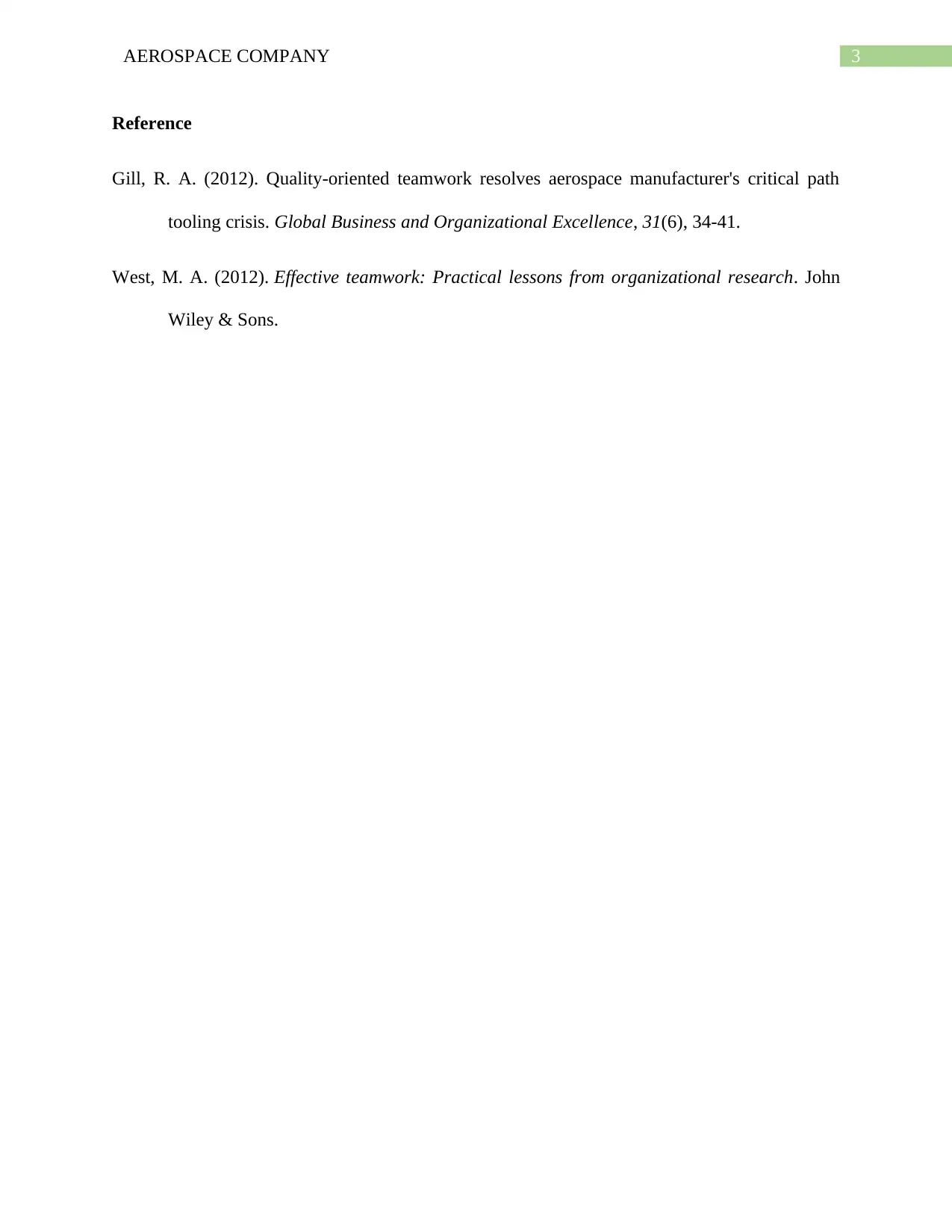Aerospace Company Case: Quality Teamwork Resolves Critical Crisis
VerifiedAdded on 2023/06/13
|4
|623
|214
Case Study
AI Summary
This case study examines how an aerospace company addressed a critical tooling crisis stemming from the loss of a key supplier. A cross-functional team of subject matter experts was assembled to clarify the problem and develop solutions. The team, initially challenged by geographic separation, est...

Running head: AEROSPACE COMPANY
Aerospace Company
Name of the Student:
Name of the University:
Author Note:
Aerospace Company
Name of the Student:
Name of the University:
Author Note:
Paraphrase This Document
Need a fresh take? Get an instant paraphrase of this document with our AI Paraphraser

1AEROSPACE COMPANY
Introduction
The efforts of a team are always yielding better results than an individual effort. However,
groups also encounter several issues related to disagreement, infighting, a direction of the project
and the vagueness. Thus, the most skilled teams require the improvement in the teamwork and
this can be achieved by several ways (West, 2012). This study is based on the implementation of
changes for the purpose of improving the quality teamwork and the company considered is an
aerospace company.
Three ways of team improvement in the Aerospace Company
A cross-functional critical path team was formed which contained 12 subject matter
experts and the aerospace company. The team was assembled for the purpose of fabricating the
company and the heat suppliers were assembled. The 12 members were chosen based on the
follow-up, implementation, planning, project development, process ownership, expertise, job
responsibility. The main target was to establish a concise and clear communication with all the
stakeholders. The members that were selected for the Aerospace Company was also based on the
ability to interact, good communications skills and the ability of the team members to interact in
a team structure. Initially, the geographic separation of the team members served as a problem
because the members were located at the three different states and this led to the complexity in
the project completion. However, this was later overcome by establishing a comprehensive
communication plan (Gill, 2012).
The Project Management Interest Group (PMIG) facilitated a forum for the increased
amount of awareness regarding the ideas of the project management within the organization. The
memberships were made open for all the employees. The Community of Excellence served as an
Introduction
The efforts of a team are always yielding better results than an individual effort. However,
groups also encounter several issues related to disagreement, infighting, a direction of the project
and the vagueness. Thus, the most skilled teams require the improvement in the teamwork and
this can be achieved by several ways (West, 2012). This study is based on the implementation of
changes for the purpose of improving the quality teamwork and the company considered is an
aerospace company.
Three ways of team improvement in the Aerospace Company
A cross-functional critical path team was formed which contained 12 subject matter
experts and the aerospace company. The team was assembled for the purpose of fabricating the
company and the heat suppliers were assembled. The 12 members were chosen based on the
follow-up, implementation, planning, project development, process ownership, expertise, job
responsibility. The main target was to establish a concise and clear communication with all the
stakeholders. The members that were selected for the Aerospace Company was also based on the
ability to interact, good communications skills and the ability of the team members to interact in
a team structure. Initially, the geographic separation of the team members served as a problem
because the members were located at the three different states and this led to the complexity in
the project completion. However, this was later overcome by establishing a comprehensive
communication plan (Gill, 2012).
The Project Management Interest Group (PMIG) facilitated a forum for the increased
amount of awareness regarding the ideas of the project management within the organization. The
memberships were made open for all the employees. The Community of Excellence served as an

2AEROSPACE COMPANY
excellent resource and it provided a tacit knowledge that is made available to all the members.
The PMIG also provided the project management training and this was in line with the
International Institute of Learning and a leading project management authority was also
considered through Harold Kerzner. The production that was having the responsibility of
mapping out a strategy for obtaining the critical fuselage parts used the Team Excellence Award
Competition criteria. This was considered as a template for the purpose of organizing its efforts
and this included: project purpose, current situation analysis, solution development, project
development, project presentation and team management (Gill, 2012).
In this part, the team members captured the knowledge collectively of the different causes that
relate to the problems of heat treat process. The issues were identified through generating a
fishbone diagram/cause and effect diagram. This facilitated the team to focus more on the
problem and not on the history of the problem. The diagrams were also used for structuring the
brainstorming the sessions because this helped to sort the ideas into the useful categories and at
the same time expand the view of the team members. This proved to be beneficial when the line
of thinking had fallen below a rut. (Gill, 2012)
excellent resource and it provided a tacit knowledge that is made available to all the members.
The PMIG also provided the project management training and this was in line with the
International Institute of Learning and a leading project management authority was also
considered through Harold Kerzner. The production that was having the responsibility of
mapping out a strategy for obtaining the critical fuselage parts used the Team Excellence Award
Competition criteria. This was considered as a template for the purpose of organizing its efforts
and this included: project purpose, current situation analysis, solution development, project
development, project presentation and team management (Gill, 2012).
In this part, the team members captured the knowledge collectively of the different causes that
relate to the problems of heat treat process. The issues were identified through generating a
fishbone diagram/cause and effect diagram. This facilitated the team to focus more on the
problem and not on the history of the problem. The diagrams were also used for structuring the
brainstorming the sessions because this helped to sort the ideas into the useful categories and at
the same time expand the view of the team members. This proved to be beneficial when the line
of thinking had fallen below a rut. (Gill, 2012)
⊘ This is a preview!⊘
Do you want full access?
Subscribe today to unlock all pages.

Trusted by 1+ million students worldwide

3AEROSPACE COMPANY
Reference
Gill, R. A. (2012). Quality‐oriented teamwork resolves aerospace manufacturer's critical path
tooling crisis. Global Business and Organizational Excellence, 31(6), 34-41.
West, M. A. (2012). Effective teamwork: Practical lessons from organizational research. John
Wiley & Sons.
Reference
Gill, R. A. (2012). Quality‐oriented teamwork resolves aerospace manufacturer's critical path
tooling crisis. Global Business and Organizational Excellence, 31(6), 34-41.
West, M. A. (2012). Effective teamwork: Practical lessons from organizational research. John
Wiley & Sons.
1 out of 4
Related Documents
Your All-in-One AI-Powered Toolkit for Academic Success.
+13062052269
info@desklib.com
Available 24*7 on WhatsApp / Email
![[object Object]](/_next/static/media/star-bottom.7253800d.svg)
Unlock your academic potential
© 2024 | Zucol Services PVT LTD | All rights reserved.





